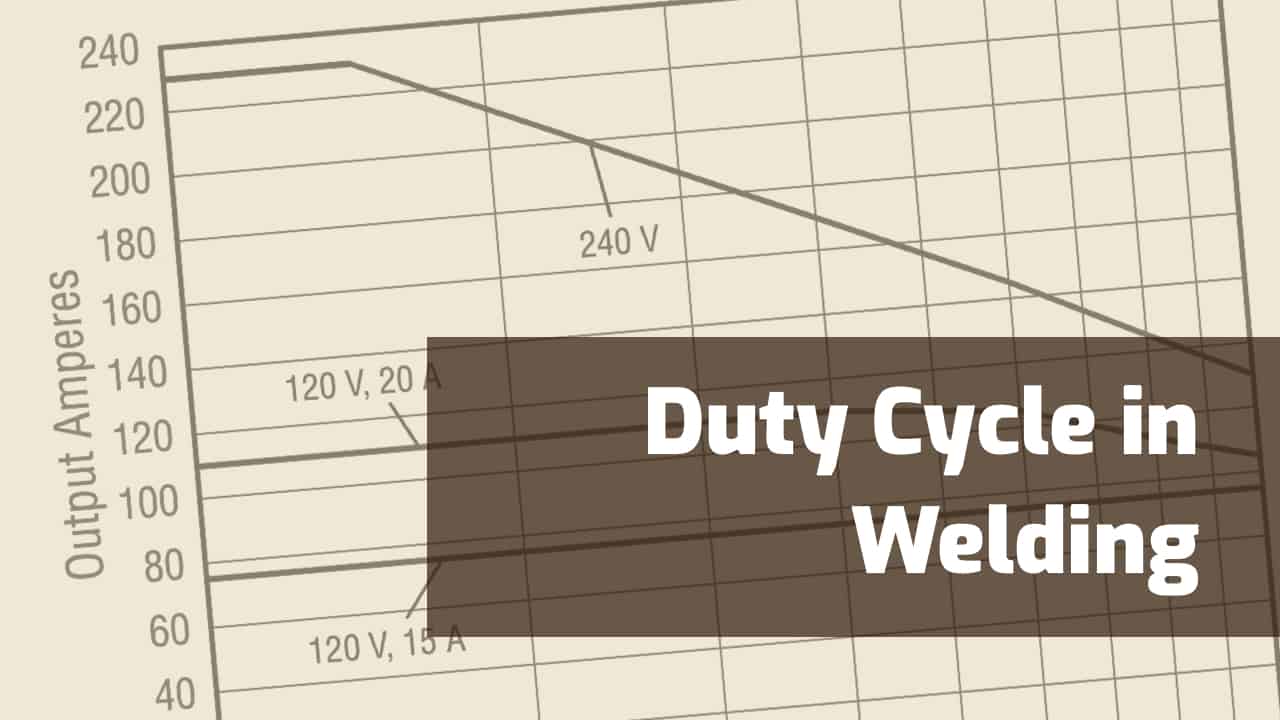Looking to understand what ‘duty cycle’ means in welding and why it’s important? You’ve come to the right place.
In this quick guide, I’ll break down the term, explain its significance in your welding tasks, and show you how to calculate it.
What Is Duty Cycle?
Simply put, the duty cycle measures how long a welding machine can operate continuously within a specific time frame, usually 10 minutes, without overheating.
It’s expressed as a percentage. For example, if a welder has a duty cycle of 60%, it means the machine can run for 6 minutes out of a 10-minute cycle. After that, it will need 4 minutes to cool down.
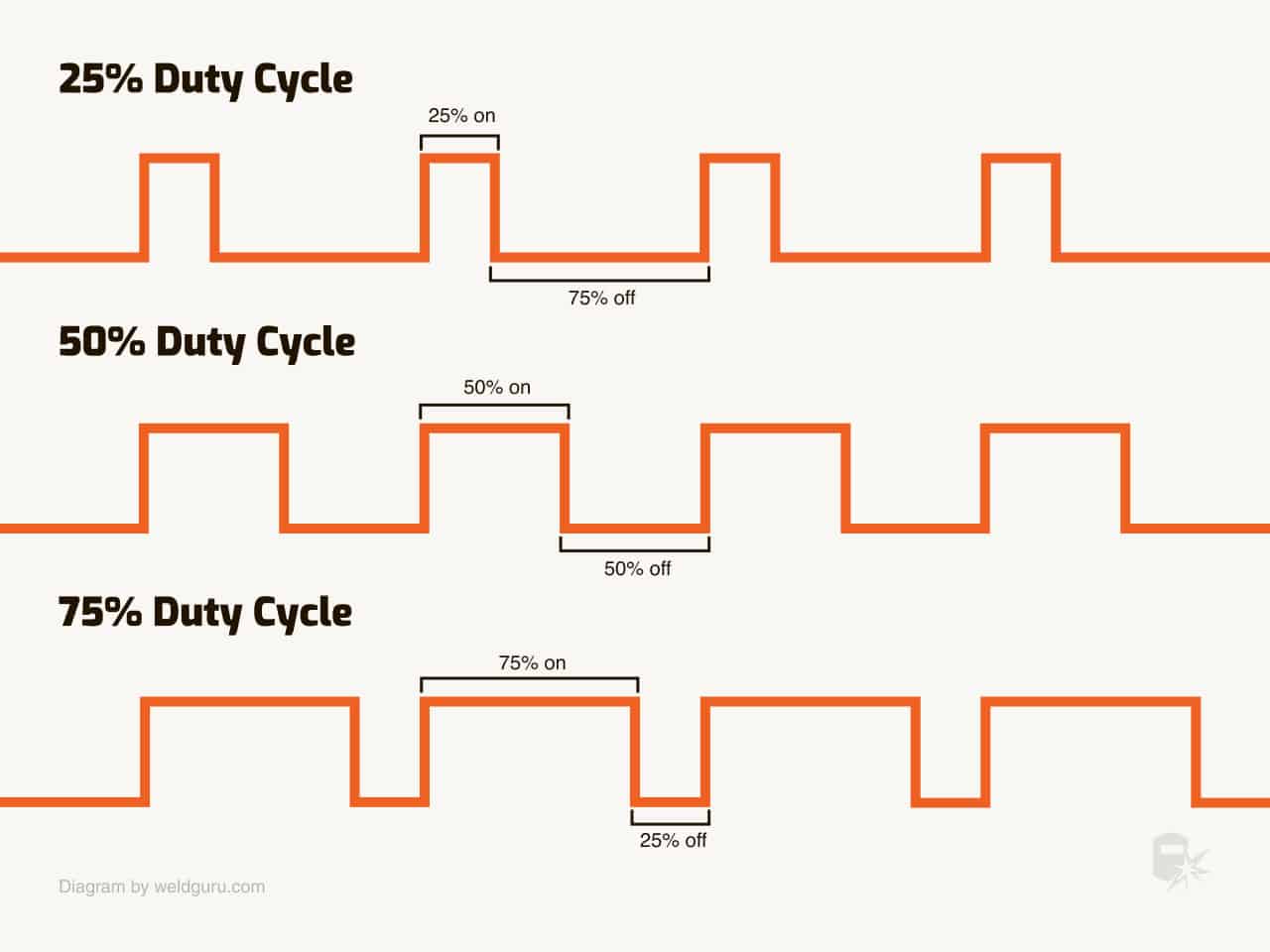
© weldguru.com – Image usage rights
Understanding the duty cycle is crucial because it gives you an idea of the welding machine’s capabilities.
It helps you gauge whether a particular machine is suitable for a job that requires continuous welding or if it’s better suited for tasks that allow periodic breaks for the machine to cool down.
The duty cycle is often indicated on the machine or in the user manual. It’s usually tested and rated at a specific amperage and temperature, so those are additional factors to keep in mind.
For example, a welder with a duty cycle rating of 200A at 60% can output 200 amps for six minutes before needing to rest for the remaining four minutes of the 10-minute interval.
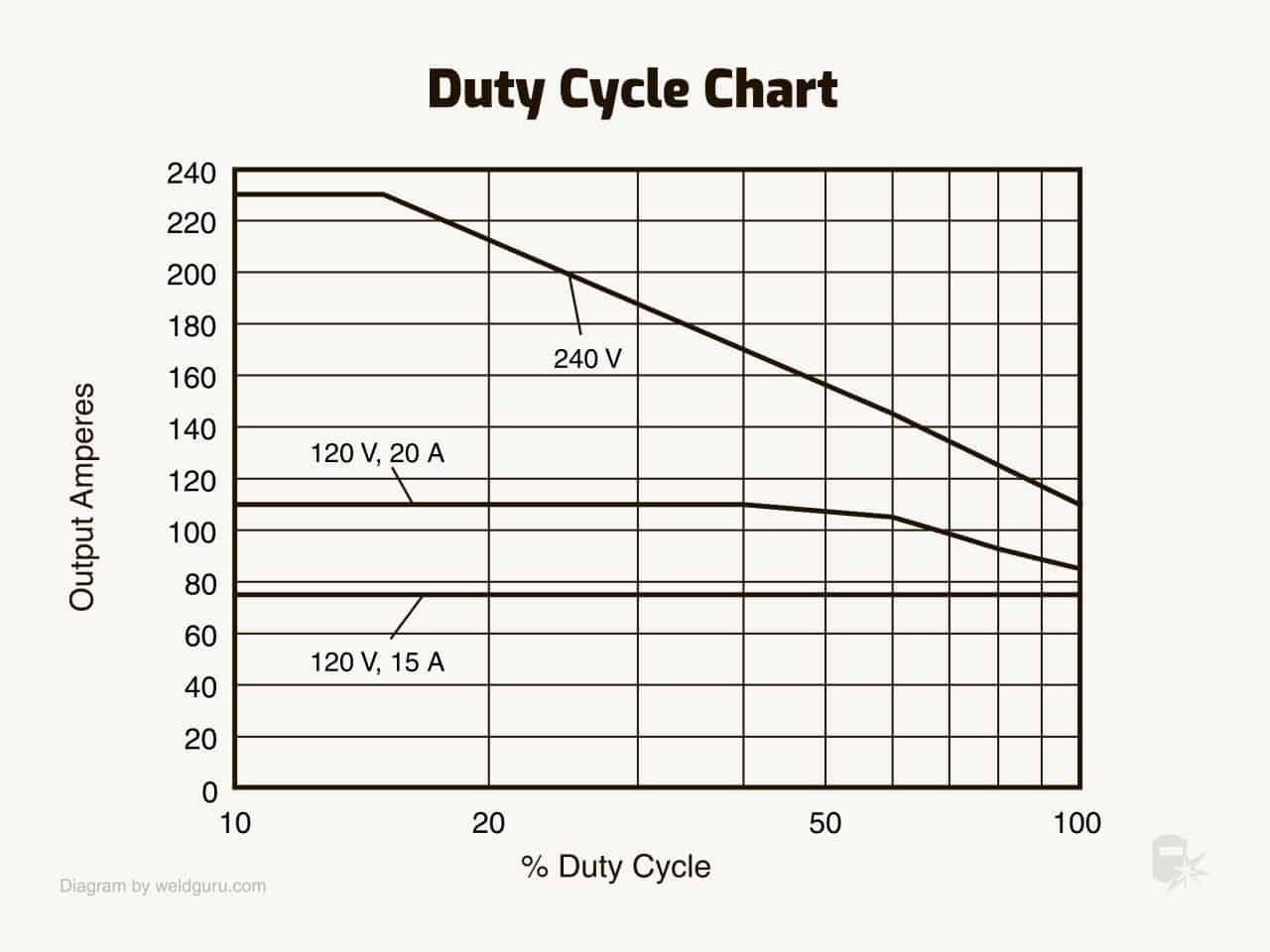
© weldguru.com – Image usage rights
The importance of Duty Cycle in welding
Understanding the duty cycle is crucial because it directly impacts the types of welding jobs your machine can handle and prevents costly equipment failures.
For example, professional-grade welders generally feature longer duty cycles, while machines aimed at hobbyists may have shorter ones.
Welding machines are engineered with a specific duty cycle to prevent thermal overload, where the arc power cuts off, but the cooling fan continues to operate.
This safety feature protects internal components like IGBT transistors, transformers, rectifiers, capacitors, and resistors from overheating and potential failure.
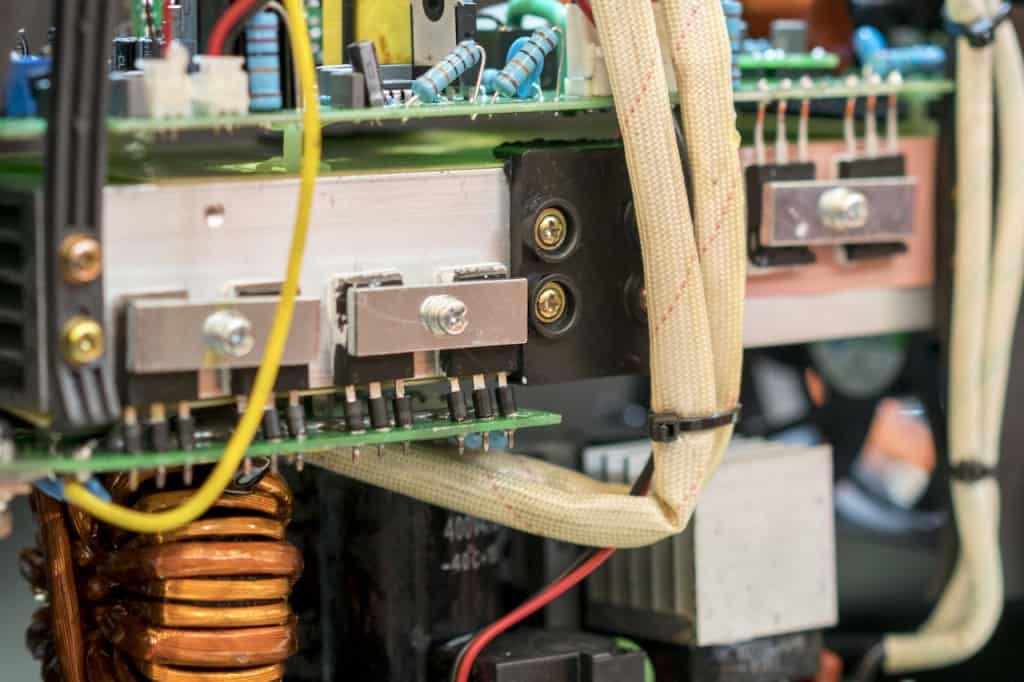
As you weld, these internal components generate heat, with higher amperage output resulting in more heat.
Manufacturers rigorously test their welding machines to determine the optimal duty cycle, ensuring that you can operate the machine safely and efficiently for varying job requirements.
By keeping within the specified duty cycle, you can maximize your welding machine’s longevity and performance, making it a vital metric to consider.
How to Calculate Duty Cycle
Knowing the importance of duty cycle, the next logical step is figuring out how to calculate it for your specific welding tasks.
Don’t worry, the math isn’t complicated, and understanding it can help you get the most out of your equipment.
The Basic Formula
The duty cycle is generally expressed as a percentage and the formula to calculate it is straightforward:
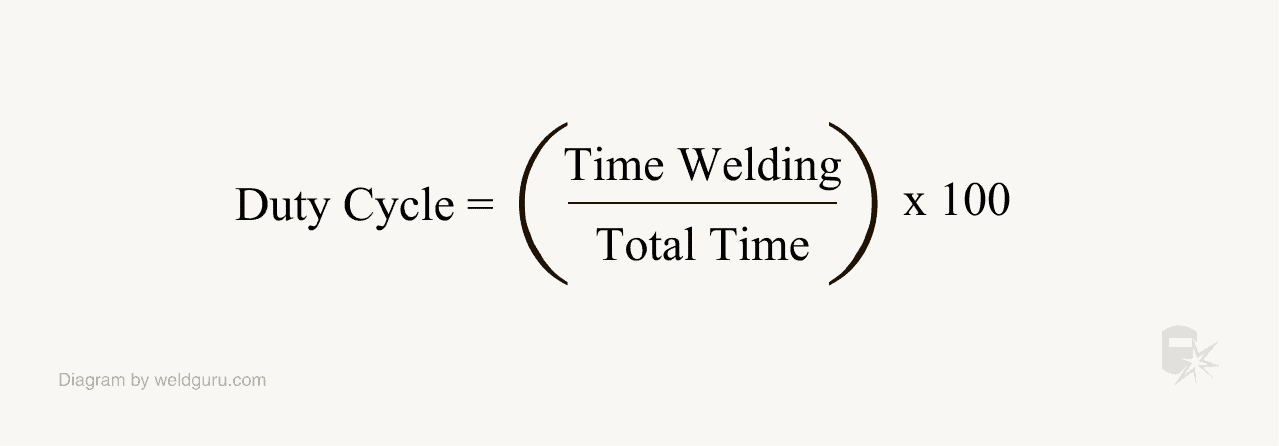
© weldguru.com – Image usage rights
In this formula, “Time Welding” refers to the number of minutes you spend actively welding, and “Total Time” is the full 10-minute standard cycle for most machines.
Practical Example
Let’s say you’ve been welding continuously for 6 minutes within a 10-minute time frame. To find the duty cycle, you would plug the numbers into the formula like this:
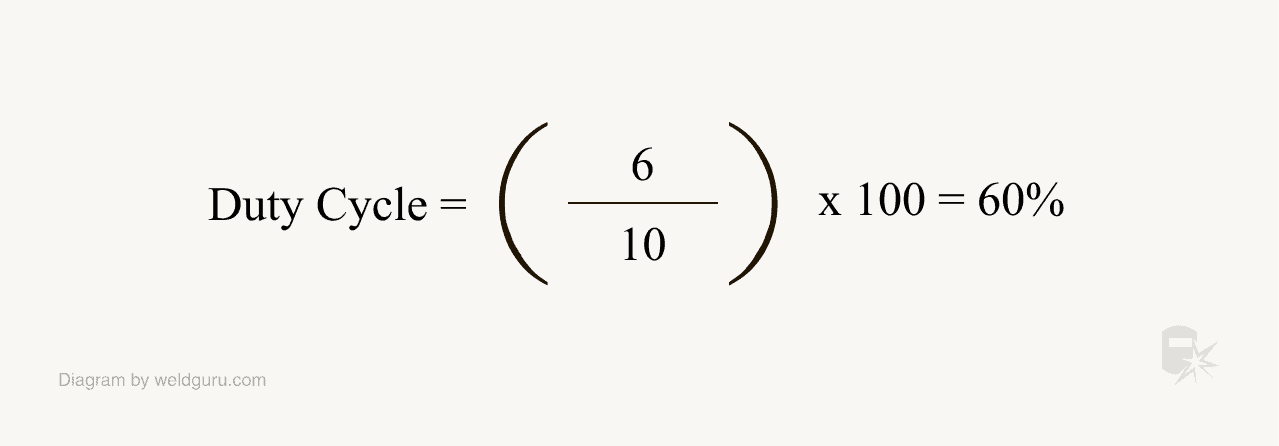
© weldguru.com – Image usage rights
This means you’ve been operating at a 60% duty cycle, and the machine would need a 4-minute cooling period to complete the 10-minute cycle.
Additional Factors
Remember that duty cycles are often rated at specific amperages and ambient temperatures. The effective duty cycle may be lower if you’re welding at a higher amperage or in a hotter environment than the rated conditions.
In summary, understanding how to calculate the duty cycle can greatly assist you in planning your welding tasks and choosing the right machine for the job. With this knowledge, you can weld more effectively and safely.
Factors That Affect Duty Cycle
While the duty cycle percentage is a critical metric for any welding project, several factors can influence this number.
Understanding these variables can help you make more informed decisions and optimize your welding activities.
- Ambient Temperature: Higher temperatures can lower the effective duty cycle, requiring more frequent cooling periods.
- Welding Current: Increased amperage generates more heat, potentially reducing the duty cycle. Always consult your machine’s specifications for guidance.
- Machine Condition: Wear and tear over time can diminish a machine’s performance, affecting its duty cycle. Regular maintenance is crucial.
- Welding Position: Different welding positions (flat, horizontal, vertical, overhead) can have varied power requirements, thus influencing the duty cycle.
- Cooling Systems: Advanced cooling mechanisms can extend the duty cycle, especially beneficial for heavy-duty welding tasks.
Warning: Duty Cycle Is Not Always Tested the Same Way
Make sure the welding machine you buy follows the widely accepted AS or EN60974-1 standard for duty cycle testing.
Machines not following this standard may offer misleading duty cycle ratings, making it impossible to make a fair comparison between different brands.
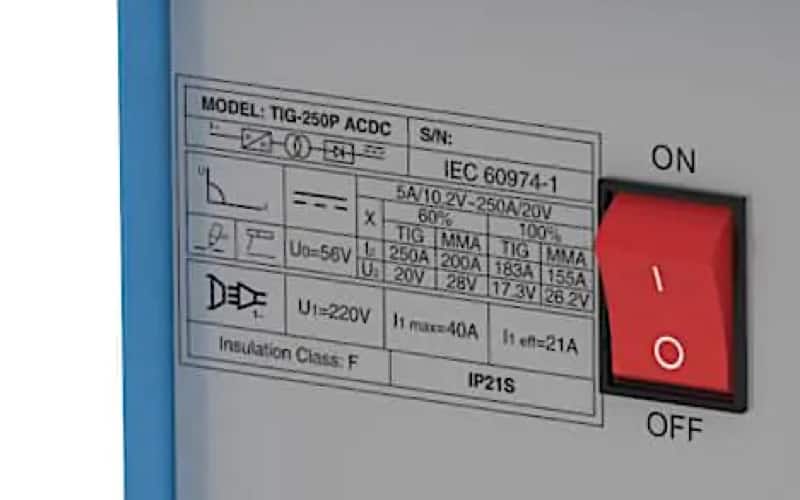
Variability Among Brands
Brands may use different testing timeframes or ambient temperatures, inflating their duty cycle numbers. The 10-minute test at 40°C is the industry standard, but some brands deviate to claim higher ratings.
Impact of Deviating Standards
Deviation from the standard means the machine isn’t following AS60974-1 or EN60974-1, potentially compromising quality.
Such machines often skip rigorous testing, like enduring 100 to 200 consecutive thermal overloads, depending on their rated duty cycle.

The Real-World Relevance
Misleading tests are not reflective of real-world use where a machine must maintain its duty cycle after multiple thermal overloads.
Always check for the AS or EN60974-1 standard on the specification plate or in the user manual.
By being aware of these testing disparities, you can make a more informed choice and avoid falling victim to marketing tricks.
What happens When the Duty Cycle is Exceeded?
Going beyond your machine’s duty cycle risks triggering the thermal overload safety feature and shortens your welder’s lifespan. For machines without this safety feature, the risk of fire or part failure is even higher.
The Role of Thermal Overload
Most machines have built-in thermocouples to monitor internal temperatures. Once a critical point is reached, the machine automatically shuts down. Never unplug the machine in this state; cooling fans should continue running to dissipate heat.
The Long-Term Consequences
Continuously exceeding the duty cycle wears down internal components and their insulation, ultimately causing equipment failure. Modern welders contain sensitive components like resistors and capacitors that can fry if pushed too hard.
Protecting Sensitive Components
Components in modern welders often have tiny, hair-width connections. Excessive heat can damage these delicate parts. Always adhere to the specified duty cycle limits to maintain equipment integrity.
By understanding the risks and mechanisms of exceeding the duty cycle, you can prolong the life of your machine and ensure safer operation.
Wrapping It
It’s not always possible to directly compare the duty cycles of two welders. Manufacturers may vary their testing methods. So, the comparison doesn’t mean much unless you compare brands that follow the same test standard.
Get a welder with a higher duty cycle if your budget allows it. It’s better to be safe than sorry.
However, if you don’t plan to weld often or make long beads, it’s okay to save money and get a less expensive machine. You should prioritize warranty over the duty cycle, especially when a brand claims a high duty cycle but provides a short warranty.
Finally, the duty cycle is not the only thing to consider when purchasing a welder. Ensure that the machine has the power for the thickness you intend to weld and the features necessary for the materials you wish to join.
For example, if you want to weld aluminum, a MIG welder must support a spool gun, while a TIG welder needs to output AC. So, make sure that the machine can achieve what you need first, and then consider the duty cycle.
